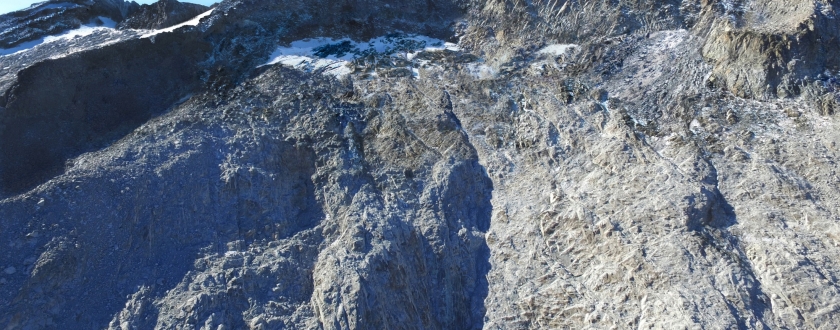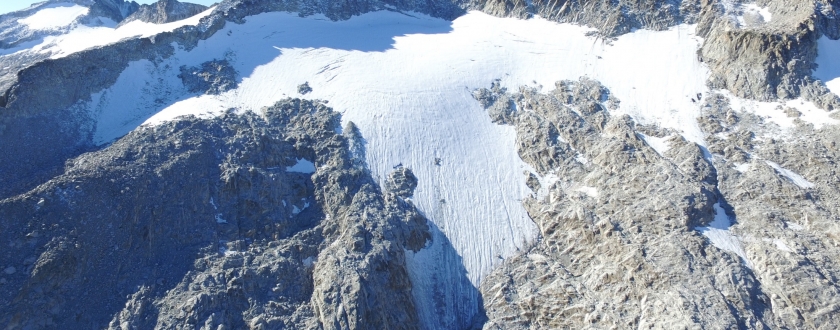Climate change adaptation study of the water resources resulting from snow and ice melt using hydrological modelling
Description of the case study
Detailed knowledge of the influence of climate change on natural resources in the form of snow and ice is essential to make progress in the conservation and adaptation of sensitive high mountain ecosystems. This research project is led by SPESA, a company specialising in these types of studies. The research applies the most advanced technology to the Maladeta glacier. An analysis of the latest data available was carried out, indicating a loss of 20 metres in depth since the 1990s, when systematic glacier monitoring began as one of the key climate change evolution indicators.
The information exchange and consultation platform on Climate Change adaptation in Spain (adaptecca.es) presents 12 climate models for two greenhouse gas emission climate scenarios (RCPs), which have been taken as a baseline for future projections through the development of hydrological modelling.
Distributed ASTER hydrological modelling allows the accumulation and fusion of ice and snow, the glacier’s height, orientation, and slope, and its transformation into run-off water to be taken into account.
Glaciers are valuable indicators of snow, and therefore hydrological activity. They provide information on annual accumulation and register year-over-year climate variations in the form of fluctuations of their terminus. As such, their study becomes a useful instrument for measuring the direction and magnitude of climate changes, and in the specific case of Pyrenean glaciers such as La Maladeta, their meridional position bestows them exceptional and almost singular value on an international level.
The main objectives of the project are as follows:
- Estimating future glacier evolution, calculating the glacier’s permanence.
- Selecting the climate models (from the 12 existing ones) which can be best adapted to the study region and determine retrospectively the temperatures and precipitation levels which occurred in the park during the 1850s —a time long before the existence of climate records for the zone.
- As a transversal objective, the project will generate new knowledge on the effects of climate change on the remaining Pyrenean glaciers, with a view to making the population more aware of an issue which is of huge importance to society.
The following actions have been developed within the framework of the basic scientific research project to improve knowledge and guide future management measures:
*Development of different climate models to estimate the future evolution of the glacier, resulting in a calculation of the glacier's remaining lifetime up to 2040-2050 for the most plausible scenarios.
*Validation of the two climate models best adapted to the Posets-Maladeta Natural Park, contributing to the design of adaptation measures necessary for the park's conservation.
*Detailed description of the forthcoming physiographic change in the Maladeta glacier aimed at preparing managers of the Posets-Maladeta Natural Park for its future management.
*Production of an analysis and simulation tool which can be used to analyse the future availability of water resources at other glaciers and in other mountain zones.
*Communication of the results with a focus on raising awareness among the scientific community and the general population about the effects of climate change on the remaining Pyrenean glaciers.
Case study developed, implemented, and partly funded as a climate change adaptation measure.
Biodiversity Foundation
Additional Information
» Posets-Maladeta Natural Park
» Pyrenean Glacier Natural Monument Trust
» Aragon Nature Protection Council
» Government of Aragon
» Ebro River Basin Authority
» Ministry for Ecological Transition
» Universitat Politècnica de València
» Posets-Maladeta natural park agent recommendations and directives report.
» Awareness-raising events
» Results published online.
The project has been awarded €32,788 in grant funding from the Biodiversity Foundation.
Research project developed as part of the Biodiversity Foundation announcement of grants for climate change adaptation projects.
09/01/2017 - 6/30/2018 (2 years - Completed)
Reference information
PYRENEAN CLIMATE CHANGE OBSERVATORY
Avenida Nuestra Señora de la Victoria, 8
22.700 - Jaca
Huesca - España
+34 974 36 31 00
info_opcc@ctp.org






